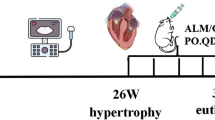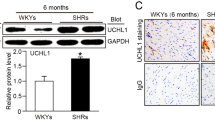Abstract
Left ventricular hypertrophy is an adaptive response to hypertension, and an independent clinical risk factor for cardiac failure, sudden death, and myocardial infarction. As regression of cardiac hypertrophy is associated with a lower likelihood of cardiovascular events, it is recognized as a target of antihypertensive therapy. This necessitates identification of factors associated with the initiation and progression of hypertrophy. Oxidative stress and metabolic shift are intimately linked with myocardial hypertrophy, but their interrelationship is not clearly understood. This study proposes to identify the temporal sequence of events so as to distinguish whether oxidative stress and metabolic shift are a cause or consequence of hypertrophy. Spontaneously hypertensive rat (SHR) was used as the experimental model. Cardiac hypertrophy was apparent at 2 months of age, as assessed by hypertrophy index and brain natriuretic peptide gene expression. Enhanced myocardial lipid peroxidation accompanied by nuclear factor-kappa B gene expression in one-month-old SHR suggests that oxidative stress precedes the development of hypertrophy. Metabolic shift identified by reduction in the expression of peroxisome proliferator-activated receptor-alpha, medium chain acyl CoA dehydrogenase, and carnitine palmitoyltransferase 1β was seen at 4 months of age, implying that reduction of fatty acid oxidation is a consequence of hypertrophy. Information on the temporal sequence of events associated with hypertrophy will help in the prevention and reversal of cardiac remodeling. Investigations aimed at prevention of hypertrophy should address reduction of oxidative stress. Both, oxidative stress and metabolic modulation have to be considered for studies that focus on the regression of hypertrophy.





Similar content being viewed by others
References
Grossman E (2008) Does increased oxidative stress cause hypertension? Diabetes Care 31(Suppl. 2):S185–S189
Harrison DG, Gongora MC (2009) Oxidative stress and hypertension. Med Clin North Am 93:621–635
Kuster GM, Kotlyar E, Rude MK et al (2005) Mineralocorticoid receptor inhibition ameliorates the transition to myocardial failure and decreases oxidative stress and inflammation in mice with chronic pressure overload. Circulation 111:420–427
Date MO, Morita T, Yamashita N et al (2002) The antioxidant N-2-mercaptopropionyl glycine attenuates left ventricular hypertrophy in in vivo murine pressure-overload model. J Am Coll Cardiol 39:907–912
Chen QM, Tu VC, Wu Y, Bahl JJ (2000) Hydrogen peroxide dose dependent induction of cell death or hypertrophy in cardiac myocytes. Arch Biochem Biophys 373:242–248
Pimentelab DR, Adachiac T, Idod Y et al (2006) Strain-stimulated hypertrophy in cardiac myocytes is mediated by reactive oxygen species-dependent Ras S-glutathiolation. J Mol Cell Cardiol 41:613–622
Adiga IK, Nair RR (2007) A positive association between cardiomyocyte volume and serum malondialdehyde level. Int J Cardiol 115:246–248
Preeta R, Nair RR (2000) Superoxide anions mediate proliferative response in cardiac fibroblasts. Indian J Med Res 111:13–18
Reaven GM, Hoffman BB (1989) Hypertension as a disease of carbohydrate and lipoprotein metabolism. Am J Med 87(Suppl 6A):2S–6S
Reaven GM, Lithell H, Landsberg L (1996) Hypertension and associated metabolic abnormalities—the role of insulin resistance and the sympathoadrenal system. N Engl J Med 334:374–381
Kelly DP, Strauss AW (1994) Inherited cardiomyopathies. N Engl J Med 330:913–919
Karbowska J, Kochan Z, Smolenski RT (2003) Peroxisome proliferator-activated receptor alpha is downregulated in the failing human heart. Cell Mol Biol Lett 8:49–53
Vlahopoulos S, Boldogh I, Casola A, Brasier AR (1999) Nuclear factor-κB–dependent induction of interleukin-8 gene expression by tumor necrosis factor a: evidence for an antioxidant sensitive activating pathway distinct from nuclear translocation. Blood 94:1878–1889
Aiello EA, Villa-Abrille MC, Escudero EM et al (2004) Myocardial hypertrophy of normotensive Wistar-Kyoto rats. Am J Physiol Heart Circ Physiol 286:H1229–H1235
Hang T, Huang Z, Jiang S et al (2006) Apoptosis in pressure overload-induced cardiac hypertrophy is mediated, in part, by adenine nucleotide translocator-1. Ann Clin Lab Sci 36:88–95
Niehaus WG Jr, Samuelsson B (1968) Formation of malonaldehyde from phospholipid arachidonate during microsomal lipid peroxidation. Eur J Biochem 6:126–130
Livak KJ, Schmittgen TD (2001) Analysis of relative gene expression data using real-time quantitative PCR and the 2 (delta delta CT–method). Methods 25:402–408
Delgado JG, Lazaro A, Osende JI et al (2006) Proteomic analysis of early left ventricular hypertrophy secondary to hypertension: modulation by antihypertensive therapies. Am Soc Nephrol 17:159–164
Kokubo M, Uemura A, Matsubara T, Murohara T (2005) Noninvasive evaluation of the time course of change in cardiac function in spontaneously hypertensive rats by echocardiography. Hypertens Res 28:601–619
Gupta S, Young D, Sen S (2005) Inhibition of NF-κB induces regression of cardiac hypertrophy, independent of blood pressure control, in spontaneously hypertensive rats. Am J Physiol Heart Circ Physiol 289:H20–H29
Álvarez MC, Caldiz C, Fantinelli JC et al (2008) Is cardiac hypertrophy in spontaneously hypertensive rats the cause or the consequence of oxidative stress? Hypertens Res 31:1465–1476
Akki A, Seymour A-ML (2006) Mitochondrial fatty acid utilization genes are down-regulated in cardiac hypertrophy. Cardiovasc Drugs Ther 20:395–424
Christe ME, Rodgers RL (1994) Altered glucose and fatty acid metabolism in heart of spontaneously hypertensive rat. J Mol Cell Cardiol 26:1371–1375
Vericel E, Narce M, Ulmann L, Poisson JP, Lagarde M (1994) Age-related changes in the anti oxidant defence mechanisms and peroxidation in isolated hepatocytes from spontaneously hypertensive and normotensive rats. Mol Cell Biochem 132:25–29
Acknowledgments
The financial support extended by Kerala State Science Technology and Environment Council is gratefully acknowledged. Ms. Sreeja Purushothaman was the recipient of Research Fellowship from the Council of Scientific and Industrial Research, India. Real time RT-PCR analysis was carried out at the Rubber Research Institute of India, Rubber Board, Kottayam, India. The authors are grateful to the Sree Chitra Tirunal Institute for Medical Sciences and Technology, Trivandrum, India, for the facilities to carry out the study and permission to publish the findings.
Author information
Authors and Affiliations
Corresponding author
Rights and permissions
About this article
Cite this article
Purushothaman, S., Renuka Nair, R., Harikrishnan, V.S. et al. Temporal relation of cardiac hypertrophy, oxidative stress, and fatty acid metabolism in spontaneously hypertensive rat. Mol Cell Biochem 351, 59–64 (2011). https://doi.org/10.1007/s11010-011-0711-y
Received:
Accepted:
Published:
Issue Date:
DOI: https://doi.org/10.1007/s11010-011-0711-y




